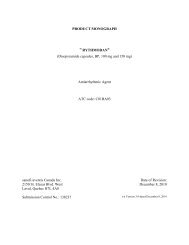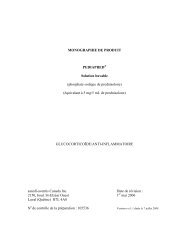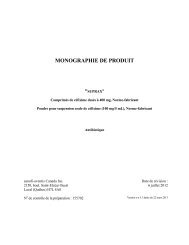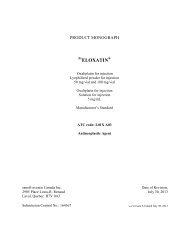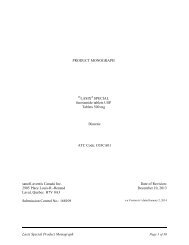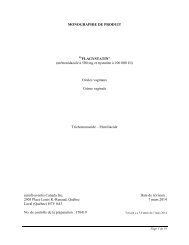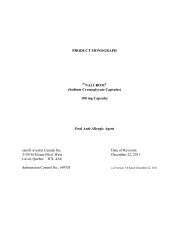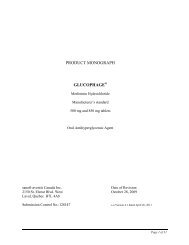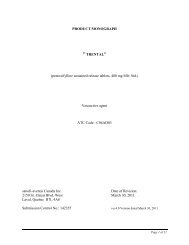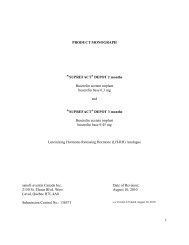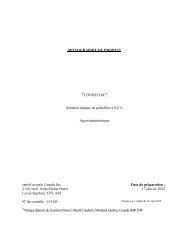pHisoHex (hexachlorophene) - Sanofi Canada
pHisoHex (hexachlorophene) - Sanofi Canada
pHisoHex (hexachlorophene) - Sanofi Canada
- No tags were found...
You also want an ePaper? Increase the reach of your titles
YUMPU automatically turns print PDFs into web optimized ePapers that Google loves.
Prescribing Information<strong>pHisoHex</strong> ®(<strong>hexachlorophene</strong>)Bottles of 150 mL, 450 mLPharmaceutical standard: USPAntibacterial – Skin Cleansersanofi-aventis <strong>Canada</strong>, Inc.2150 St. Elzear Blvd. WestLaval, Quebec H7L 4A8Date of Revision:April 21, 2006Submission Control No.: 105340 s -a Version 1.2 dated March 11, 2011
<strong>pHisoHex</strong> ®Prescribing InformationDescription: <strong>pHisoHex</strong> is an antibacterial sudsing emulsion. It contains entsufon(sodium octylphenoxyethoxyethyl ether sulfonate), lanolin cholesterols, petrolatum and3% <strong>hexachlorophene</strong> on a total weight basis. It is a colloidal dispersion of the activeingredients in a stable emulsion. Entsufon is a synthetic detergent which is effective inmany kinds of water hard or soft, cold or hot and under acid as well as alkalineconditions.Indications: A general antibacterial cleansing agent with bacteriostatic activity againststaphylococci and other gram-positive bacteria. It is indicated for use as a surgical scruband for thorough washing and cleansing of the skin, to reduce bacterial colonization andto prevent the spread of infection.Contraindications: Do not use on burned or denuded skin; as an occlusive dressing, wetpack or lotion; as vaginal pack or tampon, on mucous membranes or for routineprophylactic total body bathing.Should not be used on persons hypersensitive to any of its components nor on personswho have demonstrated primary light sensitivity to halogenated phenol derivativesbecause of the possibility of cross-sensitivity to <strong>hexachlorophene</strong>.Precautions: Rinse thoroughly after use especially from sensitive areas such as thescrotum and perineum. Patients should be closely monitored and use should beimmediately discontinued at the first sign of any of the symptoms described below.Rapid absorption of <strong>hexachlorophene</strong> may occur with resultant toxic blood levels whenpreparations containing <strong>hexachlorophene</strong> are applied to skin lesions such as ichthyosiscongenita, the dermatitis of Letterer-Siwe's syndrome, or other generalizeddermatological conditions. Application to burns has also produced neurotoxicity anddeath. Detectable blood levels of <strong>hexachlorophene</strong> following absorption through intactskin have been found in subjects who regularly scrubbed with <strong>hexachlorophene</strong> 3%.Hexachlorophene should be discontinued promptly if signs or symptoms of cerebralirritability occur.Children: Infants, especially premature infants or those with dermatoses, are particularlysusceptible to <strong>hexachlorophene</strong> absorption. Systemic toxicity may be manifested by signsof CNS stimulation (irritation) sometimes with convulsions.
Infants have developed dermatitis, irritability, generalized clonic muscular contractionsand decerebrate rigidity following application of 6% <strong>hexachlorophene</strong> powder.Examinations of brain stems of these cases revealed vacuolization like that which can beproduced in newborn experimental animals following repeated topical application of 3%<strong>hexachlorophene</strong>. Moreover, a histological study has shown a positive correlationbetween <strong>hexachlorophene</strong> baths and brain tissue lesions in premature infants who died ofunrelated causes.Intended for external use only. If swallowed, it is especially harmful to infants andchildren. Do not pour into measuring cups, medicine bottles, or similar containers since itmay be mistaken for baby formula or other medication.Suds that get into the eyes accidentally during washing should be rinsed out promptly andthoroughly with water.Periorbital skin and head application should be performed while the patient is conscious,so that eye irritation can be reported immediately.Topical exposure of neonatal rats to 3% <strong>hexachlorophene</strong> solution caused reducedfertility in 7-month-old males, due to inability to ejaculate.Pregnancy: Hexachlorophene is embryo toxic and produces some teratogenic effects inrats. There are no adequate studies in pregnant women. Hexachlorophene should be usedduring pregnancy only if the potential benefits justify potential risk to the fetus.Hexachlorophene has been shown to be teratogenic and embryotoxic in rats when givenby mouth or instilled into the vagina in large doses. Administration of 500 mg/kg diet or20 to 30 mg/kg body weight/day by gavage to rats caused some malformations (angulatedribs, cleft palate, micro- and anophthalmia) and reduction in litter size. Placental transferand excretion in milk of <strong>hexachlorophene</strong> has been demonstrated in rats. In anotherstudy, doses of up to 50 mg/kg diet failed to produce any effects in 3 generations of rats.Hexachlorophene did not interfere with reproduction in hamsters.Lactation: Placental transfer and excretion in milk of <strong>hexachlorophene</strong> has beendemonstrated in rats. It is not known whether this drug is excreted in human milk.Because of the potential risk to newborn infants, a decision is required to discontinuenursing or to discontinue the drug.Children: <strong>pHisoHex</strong> should not be used routinely for bathing infants (see Precautions).For premature infants, see Precautions.Adverse Effects: Adverse reactions may include dermatitis and photosensitivity.Hexachlorophene is not irritating to the skin in ordinary concentrations andhypersensitivity reactions are rare. Primary light sensitivity occurs rarely but patients who
have developed photo-allergy to other halogenated phenol derivatives may sometimesexhibit cross-sensitivity to <strong>hexachlorophene</strong>. If a sensitivity reaction occurs, discontinueuse of the product and consult a physician.Sensitive skin may react with redness and/or mild scaling or dryness, especially whenexposed to excessive rubbing, heat or cold.Use of skin products containing alcohol may decrease the antibacterial action of<strong>pHisoHex</strong>.Overdose: Symptoms: The accidental ingestion of <strong>pHisoHex</strong> in amounts from 30 to 120mL has caused anorexia, vomiting, abdominal cramps, diarrhea, dehydration,convulsions, hypotension and shock, and in several reported instances has been fatal.Treatment: If patients are seen early, the stomach should be evacuated by emesis orgastric lavage. Olive oil or vegetable oil (60 mL) may then be given to delay absorptionof <strong>hexachlorophene</strong>, followed by a saline cathartic to hasten removal. Treatment issymptomatic and supportive; i.v. fluids (5% dextrose in physiologic saline solution) maybe given for dehydration. Correct any other electrolyte derangement. If markedhypotension occurs, vasopressor therapy is indicated. Consider the use of opiates ifgastrointestinal symptoms (cramping, diarrhea) are severe. Scheduled medical or surgicalprocedures should be postponed until the patient's condition has been evaluated andstablized.Animal Toxicity: The oral LD 50 of <strong>hexachlorophene</strong> in male rats is 66 mg/kg bodyweight, in females 56 mg/kg body weight, and in weanling rats 120 mg/kg body weight.In suckling rats (10-days old), it is 9 mg/kg body weight.Dosage: To be used for scrubbing and washing following suggested procedure to effectthorough cleansing.Surgical Hand Scrub: Wet hands and forearms with water. Apply approximately 5 mL of<strong>pHisoHex</strong> over the hands and rub into a copious lather by adding small amounts of water.Spread suds over hands and forearms and scrub well with a wet brush for 3 minutes,paying particular attention to the nails and interdigital spaces. A separate nail cleaner maybe used. Rinse thoroughly under running water.Apply 5 mL to hands again and scrub as above for another 3 minutes. Rinse thoroughlywith running water and dry.For repeat surgical scrubs during the day, scrub thoroughly with the same amount of<strong>pHisoHex</strong> for 3 minutes only. Rinse thoroughly with running water and dry.
Bacteriostatic Cleansing: Wet hands with water. Dispense approximately 5 mL of<strong>pHisoHex</strong> into the palm, work up a lather with water and apply to area to be cleansed.Rinse thoroughly after each washing.Infant care: <strong>pHisoHex</strong> should not be used routinely for bathing infants (see Precautions).Premature Infants: (see Precautions).Use of baby skin products containing alcohol may decrease the antibacterial action of<strong>pHisoHex</strong>.<strong>pHisoHex</strong> should not be dispensed from, or stored in, containers with ordinary metalparts. Plastic or a special type of stainless steel must be used or undesirable discolorationof the product or oxidation of metal may occur.Supplied: Each mL of white to slightly off-white emulsion contains: <strong>hexachlorophene</strong>3%.Nonmedicinal ingredients: Entsufon sodium, lanolin cholesterols, lauryl myristyldiethanolamide, methylcellulose, petrolatum (white), polyethylene glycol, polyethyleneglycol monostearate, sodium benzoate and purified water.<strong>pHisoHex</strong> is available in bottles of 150 mL and 450 mL.STORAGE AND STABILITYTemperature:Store between 15 and 30ºC.Others:Avoid freezing.



